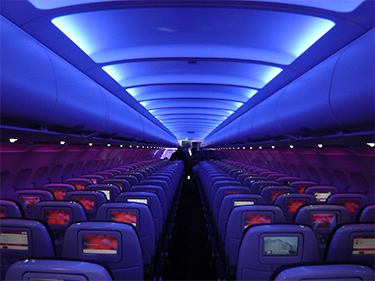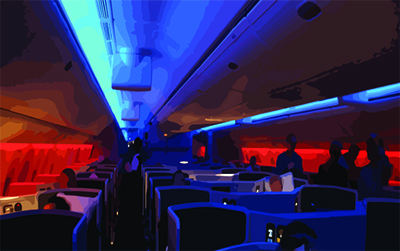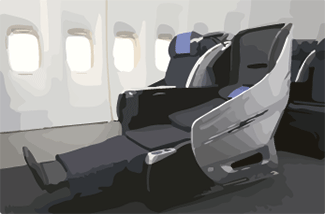InTrans / Nov 24, 2014
The future of air travel
Go! Magazine
 posted on November 24, 2014
posted on November 24, 2014
In the future, airlines will be carrying more people while using less energy. These two factors are extremely important because according to the Global Market Forecast report, from 2000 to 2013, there was a 340 percent increase in the price of oil per barrel, and a 70 percent increase in passenger air traffic. These two trends will likely continue to increase.
To put things in perspective as to why airlines need to focus on using less energy, fuel costs currently represent about one-third, or 31 percent, of total airline costs. Cutting the amount of fuel needed to move an aircraft will be vital for airlines to remain competitive in the future. The reason that there is an expected rate of air traffic is due to the growing Gross Domestic Product (GDP) around the world. In other words, different countries growing economies will mean more people will be able to afford to travel by air.
In fact, it is estimated that by 2030, 59 million people will travel by air. In 2013, the number of people flying was 30 million. -CNN
Airlines of the future
With an increased population of people flying, there will be increased competition amongst airlines. Airlines that are focused on the newest, most efficient technologies, will likely have a strong place in the market. With a growing market and growing interest, there will be a lot of room for new technologies.
Technologies from the past decade
From using composites—a combination of different elements into one—as materials for a lighter aircraft, to personal televisions at each seat, aircraft have improved in comfort and efficiency over the past few decades. Looking way into the future, it is likely that airplanes will use minimal energy; some predict airplanes will even be carbon neutral, meaning zero greenhouse gas emissions. Many travel agencies predict that airplanes will be much more comfortable than now for passengers. Some new technologies that improve the riding experience include mood lighting, more personal seating, and even beds for sleeping.
Airport stresses
Have you ever gotten on an airplane and tried to take a nap? Between not being able to move your chair and the loud noises, it makes it pretty difficult to relax, let alone fall asleep. The newest manufactured aircraft have mood lighting, which is meant to help reduce the stress related to long flights and time changes (See Figure 1).

Other technologies that help airline travelers reduce stress while in flight will be a deal breaker for many new consumers. Aircrafts of the future may also include more comfort and freedom to move around. Imagine that each person in the aircraft could have their own cabin where they could sit in peace and quiet, such as the seating in Figure 2.

There could also be a common space where people could sit together and watch movies or talk. Airline manufacturers are currently working to provide quieter airplanes, which will greatly improve people’s riding experience.
Imagine, too, that an aircraft has an area for children and their parents to play, an area for entertainment, or even a sleeping space. That seems almost too good to be true. What if this sleeping space was like the one shown in Figure 3.

How much would you be willing to pay if you could ensure a good night’s rest before starting your trip? While these sleeping beds look quite comfortable, it also costs a lot more to fly a plane with these types of seats. Because each person has more personal space, there is less density per flight, making the cost per ticket higher.
Cost of luxury
At a time when more people are demanding more flights, the price of meeting this demand will be passed on to the buyers. Some of the more luxurious aircraft will always appeal to those that want to travel in complete comfort, no matter the price. For example, Donald Trump owns a private jet with 52 inch flat screen televisions, and gold plated seat buckles, bathrooms sinks and faucets. The jet even has two bedrooms! In total, this jet cost Mr. Trump $100 million. For many people, traveling does not have to be a completely luxurious experience, especially if losing some fancy qualities means cheaper flight prices. Many airlines will remain strong in the market as long as the prices are low, and their customer service is adequate. With more demand for flights, there will be more efficient ways of getting people to their destination. Ultimately, this means there will be less instances where someone flying from Ohio to California will have a layover in New York. Hopefully these inefficiencies will also mean quicker travel times and less greenhouse gas emissions overall.
Related links
Check out the world’s most expensive aircraft: http://financesonline.com/8-most-expensive-planes-in-the-world-how-much-does-it-cost-to-fly-like-the-elite/
By Jackie Nester, Go! Staff Writer